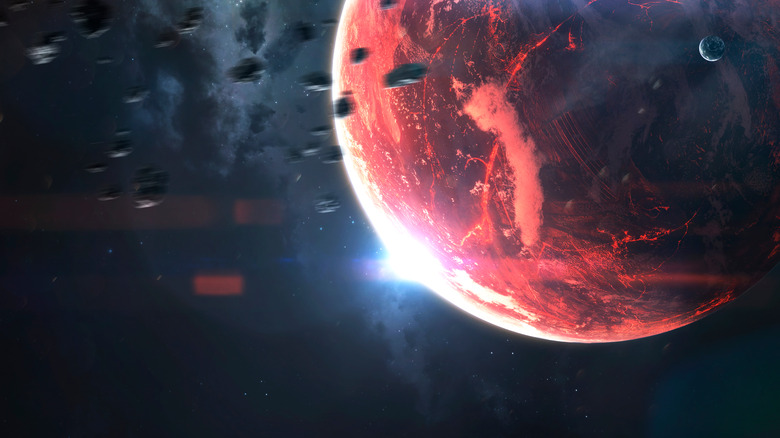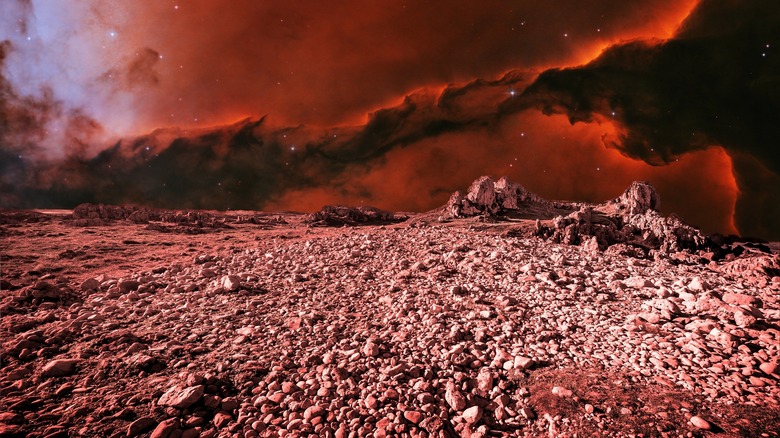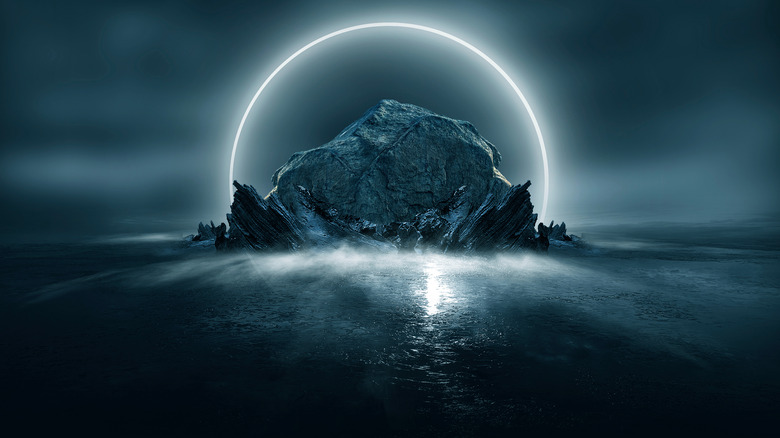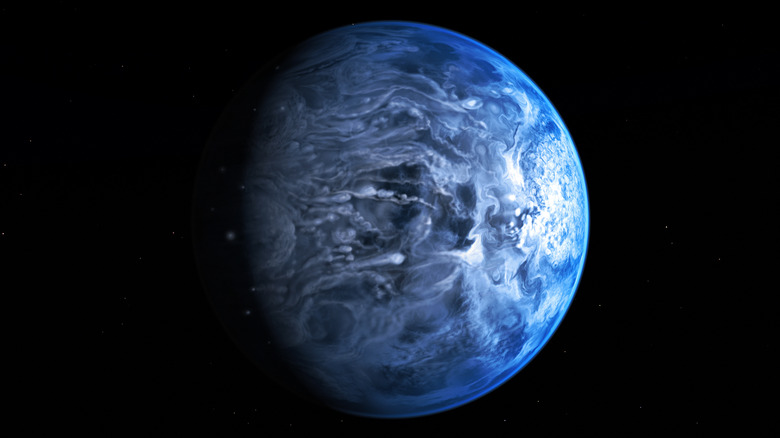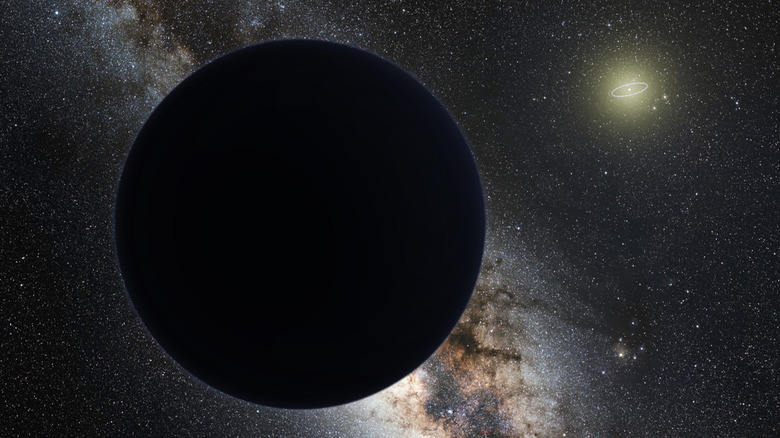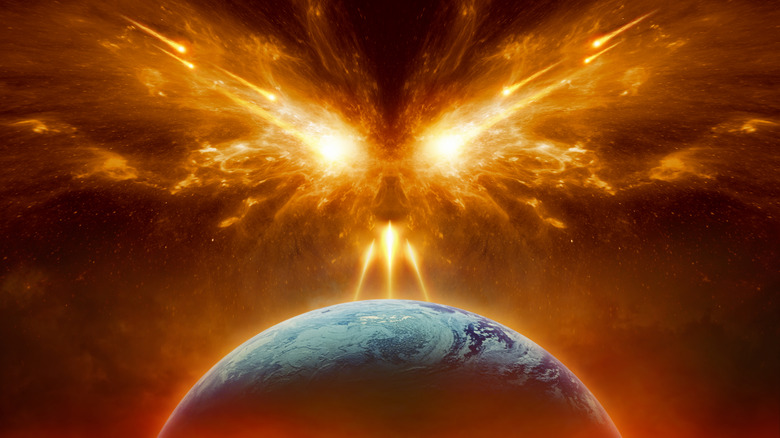The Most Extreme Exoplanets Lethal To Human Life
Blue skies, tranquil water, a light breeze rustling the trees, and all the produce you could ask for. Yep, Earth is pretty darn great. We've got reasonable temperatures, a solid day-night cycle, varied terrain and gorgeously colored flowers, and surface conditions stable enough to allow civilization to not be obliterated. Our atmosphere singes most smallish meteoroids (sorry, dinosaurs) into a disintegrative nothing before they make impact (via Sciencing). We have an electromagnetic shield that siphons ions from solar winds and makes them into smeary-colored sky art we call "auroras" (via National Geographic). We even have a perfectly sized moon whose tidal-inducing, gravitational tug might have been integral to creating life (via Scientific American).
So why would scientists ever gaze to the skies and wonder, "Are there other Earth-like planets out there?" To this we ask: have you been alive for more than 20 minutes? If we don't need a planet B to escape to, it would be comforting to know that alien life could make good on Earth's defunct consciousness experiment. As it turns out, though, quite a few exoplanets (planets outside of our solar system) are pretty hostile to human life. Earth is the perfectly balanced exception to the rule.
And yet, astrobiologists — those who check for life-creating conditions elsewhere — search on. Bear in mind, however, that a mandibular archslug from planet Xetok (not real, don't worry) might find our cozy little blue ball downright noxious in comparison to the conditions on Xetok in which it evolved.
The fiery world of lava planets
First on the planetary death list? Lava planet. Fire worlds are a fixture in sci-fi, like Mustafar in "Star Wars," where Anakin Skywalker didn't take the high ground. Seeing as how a piddling, two-degree Celsius, CO2-driven temperature difference on Earth is enough to practically ignite the surface and suffocate human life, it's not too hard to imagine that fire worlds spell death. Plus, these non-imagery versions are far, far (several more "fars" are okay) more extreme.
As NASA explains, the gas giant KELT-9b is so hot that its sun literally shreds its molecules. At 4,315 degrees Celsius (7,800 degrees Fahrenheit), the surface of KELT-9b is hotter than many stars. Because it's tidally locked, its light-side face never gets a break from a blue-hot sun that's twice as hot as our own. Kepler 10b is also tidally locked, but rocky. With a surface temperature of 1,300 degrees C (2,372 degrees F), its metals and silicates melt and are blasted by solar radiation, giving the planet a fiery tail (via Space). Kepler-78b is even worse — it's just a bubbling "abomination" of lava 40x closer to its sun than Mercury is to ours. It does a full orbit around its sun in hours.
Perhaps most unreal of all, though, is 55 Cancri e. At 2,700-degree C (4,900-degree F), some have suggested that its unreasonably heavy mass comes from having a surface or core composed of pure diamond (with lava rivers, of course). Let's see De Beers figure this one out.
Flash-frosted till dead
If it seems like there are a lot of blazing, enflamed hellworlds, well ... there are. But, those planets are typically easier to spot from Earth because they're lit up by their suns. How about the opposite: ice planets? And we mean ice, not just cold (there are loads of cold exoplanets). In our own solar system, Jupiter's moon Europa (via NASA) and Saturn's moons Enceladus and Titan (also via NASA) are all coated in ice shells or partially composed of ice. Uranus and Neptune are also "ice giants" (via Astronomy).
Outside of our solar system, we've only found one — yes, one — ice giant, and that was back in 2014 (via NASA). Why so few? Well, it seems that frozen H2O is pretty scarce, cosmos-wide (via EarthSky). The one we found basically looks like a clone of Uranus. This makes sense, though, because subzero temperatures bottom out at absolute zero, or 273 degrees Kelvin (-546 C, or -951 F). Neptune itself is over halfway there, at -330 Celsius (-200 Fahrenheit) (via NASA). Any similar planet that's far enough away from its sun and full of ice isn't going to be too dissimilar to what we've got in our own celestial backyard: frozen, calm, and lethal.
Scientists working on the newly deployed James Webb Space Telescope have basically stated, for research purposes, that we can treat Neptune and Uranus like exoplanets (via Science Direct). As to why we've got so much ice in our solar system? Just lucked out.
Storms of iron, glass, and sapphire
Time to veer back some towards extreme climatological nonsense. Rain of molten iron? Check. Hurricanes of whizzing glass? Check. Drizzles of sapphires and rubies? Check.
As Space explains, WASP-76b is another tidally locked murder orb. Like others on our list, its a blazingly hot 2,500 degrees C (4,532 degrees F). But it's got another fun feature: iron rain. The light side gets so hot that its iron evaporates like water (yes, seriously). It rises into the atmosphere, gets carried on the wind to the dark side — which is cooler than the light side (but still 1,000 degrees C, or 1,832 degrees F) — and pummels it in the form of molten iron precipitation.
HD 189733 b, by contrast, rains not molten iron, but glass. Its gorgeous, sapphire-blue surface belies some absolutely insane weather conditions. Its winds rage at 9,000 kph (5,600 mph) in nigh-horizontal motion and pick up silicates from the surface. The silicates, mostly microscopic, blast through the atmosphere like a non-stop hurricane of glass shrapnel.
Our final example of bonkers precipitation comes from WASP-121b, which heats up and drops metals similar to WASP-76b. In this case, though, as Newsweek explains, we're not talking iron, but aluminum and titanium. The metals heat up on the planet's light side, evaporate, and rain down on the planet's dark side. While up in the atmosphere, however, the aluminum condenses and mixes with titanium and other elements like chromium and iron. Bam: instant sapphire and ruby rain.
Eternal darkness and pitiless gravity
Death by fire, ice, and molten iron rain seem bad enough. But how about death by crushing gravity, broken orbits, and/or the unknown terrors of a coal-black space blind to our endless suffering?
We've seen how critical location is to planetary environment, whether close to a star, far away from it, tidally locked, etc. Some planets, though, known as rogue exoplanets, have no sun at all. They roam the cosmos snipped of gravitational tethers, and float aimlessly without home or destination. As Space explains, such planets were likely tugged out of their orbits by passing celestial bodies. Researchers tracked one of these, OGLE-2016-BLG-1928, for 41 minutes back in 2020. This is stunning in and of itself, given the absolute immensity of the universe, and it also means we can give up on tracking or predicting the appearance of other rogue exoplanets. Because they're not near any star's light, and have a wonky rotation, forget about the surface being even remotely hospitable.
Another star, TrES-2b, remains an absolute mystery. It's not only darker than the darkest acrylic paint, it's darker than any other celestial body, period. It reflects a mere 1% of the light that hits it, as Sky at Night explains, and researchers have no idea why. Even worse is a theoretical planet dubbed a "blanet." Blanets orbit black holes, not stars, at the absolute, extreme limits of planetary formation, gravitational pull, and environments. We have no idea what such surface environments would be like.
Obliterated worlds named after Cthulhu
Admit it: we are frail, upright bags of boney meat run through with little fluid vessels just waiting to be crushed, cleaved, shredded, seared, or frostbitten. We're utterly dependent on just the right, fine-tuned set of conditions to persist existing. But because we might as well drive home the point further, let's talk about "Chthonian planets," gas giants subjected to conditions so hostile that they've been stripped of all their gas. Chthonian planets are named after Greek Chthonian gods, the deities of the underworld (via Theoi). This term also likely inspired cosmic horror extraordinaire H.P. Lovecraft and his Cthulhu mythos.
So far, we've got a good candidate for a Chthonian planet, TOI 849 b. As Sky at Night describes, it's nestled very close to its star and has a surface temperature of 1,530 degrees C (2,800 F). It's as big as Neptune (four times the diameter of Earth, via Sciencing), but has a mass 40x that of Earth. How is this possible? Well, it's likely the remnant core of a much larger gas giant that got its atmosphere obliterated. Further evidence comes from other exoplanets like HD 209458b ("Osiris") currently undergoing chthonianization, so to speak (via Big Think).
All in all, these extreme exoplanets comprise a mere handful of the potentially 3.2 trillion planets in our own galaxy alone (via Universe Today). While there are more than a few cozy ones out there, the deathly ones should remind us to appreciate the Earth we've got.
